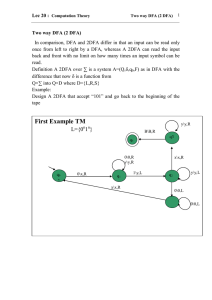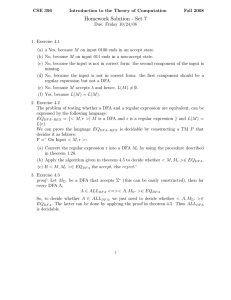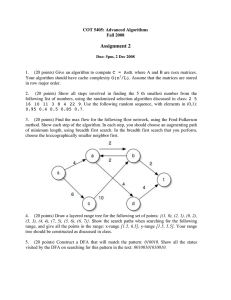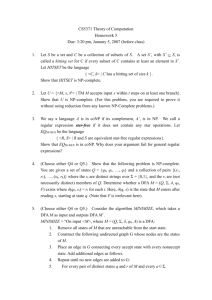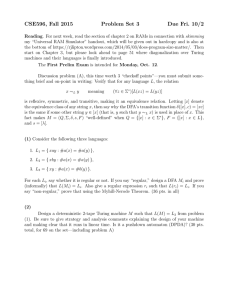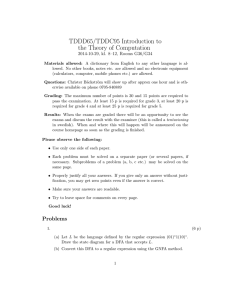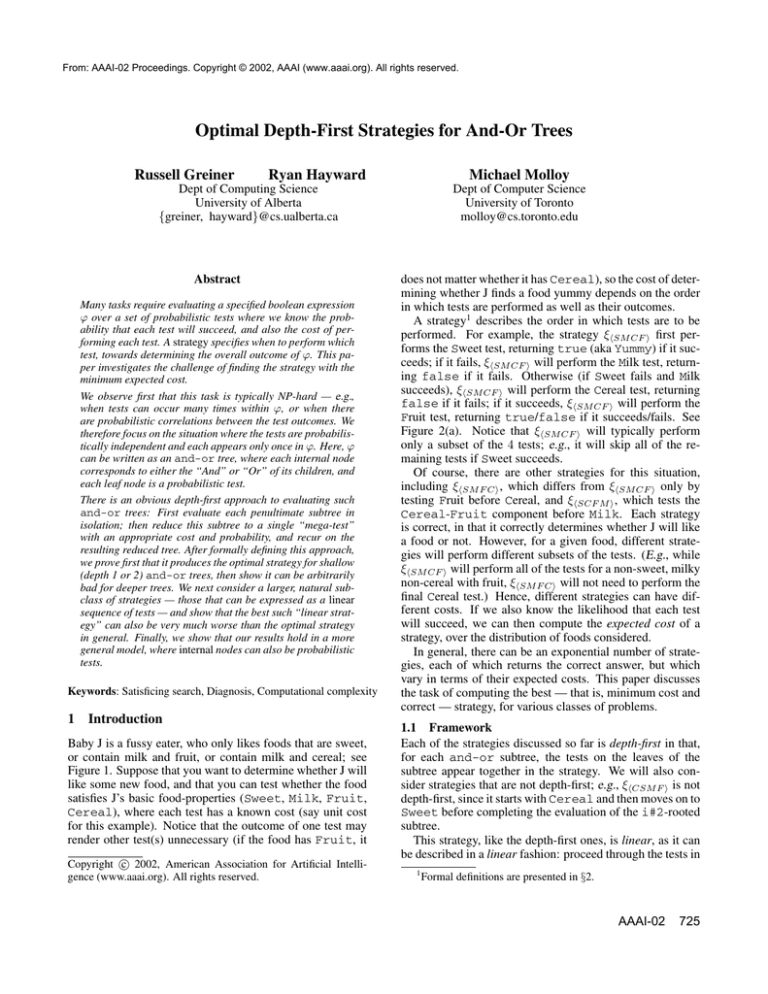
From: AAAI-02 Proceedings. Copyright © 2002, AAAI (www.aaai.org). All rights reserved.
Optimal Depth-First Strategies for And-Or Trees
Russell Greiner
Ryan Hayward
Michael Molloy
Dept of Computing Science
University of Alberta
{greiner, hayward}@cs.ualberta.ca
Abstract
Many tasks require evaluating a specified boolean expression
ϕ over a set of probabilistic tests where we know the probability that each test will succeed, and also the cost of performing each test. A strategy specifies when to perform which
test, towards determining the overall outcome of ϕ. This paper investigates the challenge of finding the strategy with the
minimum expected cost.
We observe first that this task is typically NP-hard — e.g.,
when tests can occur many times within ϕ, or when there
are probabilistic correlations between the test outcomes. We
therefore focus on the situation where the tests are probabilistically independent and each appears only once in ϕ. Here, ϕ
can be written as an and-or tree, where each internal node
corresponds to either the “And” or “Or” of its children, and
each leaf node is a probabilistic test.
There is an obvious depth-first approach to evaluating such
and-or trees: First evaluate each penultimate subtree in
isolation; then reduce this subtree to a single “mega-test”
with an appropriate cost and probability, and recur on the
resulting reduced tree. After formally defining this approach,
we prove first that it produces the optimal strategy for shallow
(depth 1 or 2) and-or trees, then show it can be arbitrarily
bad for deeper trees. We next consider a larger, natural subclass of strategies — those that can be expressed as a linear
sequence of tests — and show that the best such “linear strategy” can also be very much worse than the optimal strategy
in general. Finally, we show that our results hold in a more
general model, where internal nodes can also be probabilistic
tests.
Keywords: Satisficing search, Diagnosis, Computational complexity
1 Introduction
Baby J is a fussy eater, who only likes foods that are sweet,
or contain milk and fruit, or contain milk and cereal; see
Figure 1. Suppose that you want to determine whether J will
like some new food, and that you can test whether the food
satisfies J’s basic food-properties (Sweet, Milk, Fruit,
Cereal), where each test has a known cost (say unit cost
for this example). Notice that the outcome of one test may
render other test(s) unnecessary (if the food has Fruit, it
c 2002, American Association for Artificial IntelliCopyright gence (www.aaai.org). All rights reserved.
Dept of Computer Science
University of Toronto
molloy@cs.toronto.edu
does not matter whether it has Cereal), so the cost of determining whether J finds a food yummy depends on the order
in which tests are performed as well as their outcomes.
A strategy1 describes the order in which tests are to be
performed. For example, the strategy ξSM CF first performs the Sweet test, returning true (aka Yummy) if it succeeds; if it fails, ξSM CF will perform the Milk test, returning false if it fails. Otherwise (if Sweet fails and Milk
succeeds), ξSM CF will perform the Cereal test, returning
false if it fails; if it succeeds, ξSM CF will perform the
Fruit test, returning true/false if it succeeds/fails. See
Figure 2(a). Notice that ξSM CF will typically perform
only a subset of the 4 tests; e.g., it will skip all of the remaining tests if Sweet succeeds.
Of course, there are other strategies for this situation,
including ξSM F C , which differs from ξSM CF only by
testing Fruit before Cereal, and ξSCF M , which tests the
Cereal-Fruit component before Milk. Each strategy
is correct, in that it correctly determines whether J will like
a food or not. However, for a given food, different strategies will perform different subsets of the tests. (E.g., while
ξSM CF will perform all of the tests for a non-sweet, milky
non-cereal with fruit, ξSM F C will not need to perform the
final Cereal test.) Hence, different strategies can have different costs. If we also know the likelihood that each test
will succeed, we can then compute the expected cost of a
strategy, over the distribution of foods considered.
In general, there can be an exponential number of strategies, each of which returns the correct answer, but which
vary in terms of their expected costs. This paper discusses
the task of computing the best — that is, minimum cost and
correct — strategy, for various classes of problems.
1.1 Framework
Each of the strategies discussed so far is depth-first in that,
for each and-or subtree, the tests on the leaves of the
subtree appear together in the strategy. We will also consider strategies that are not depth-first; e.g., ξCSM F is not
depth-first, since it starts with Cereal and then moves on to
Sweet before completing the evaluation of the i#2-rooted
subtree.
This strategy, like the depth-first ones, is linear, as it can
be described in a linear fashion: proceed through the tests in
1
Formal definitions are presented in §2.
AAAI-02
725
Yummy
HH
j
H
Sweet
p=0.3 c=1
PBE”, where each test can only performed in some context
(i.e., if some boolean condition is satisfied), and shows that
the same results apply. The extended paper [GHM02] provides the proofs for the theorems.
1.2 Related Work
We close this section by framing our problem, and provid
ing a brief literature survey (see also §5.1). The notion of
MRSP appears in Simon and Kadane [SK75], who use the
Milk
i#2
H
term satisficing search in place of strategy. Application inp=0.8 c=1
H
j
H
stances include screening employment candidates for a po
sition [Gar73], competing for prizes at a quiz show [Gar73],
Cereal
Fruit
mining for gold buried in Spanish treasure chests [SK75],
p=0.2 c=1
p=0.7 c=1
and performing inference in a simple expert system [Smi89;
GO91].
Figure 1: An and-or tree, T1 . Here and-nodes are inWe motivate our particular approach by considering the
dicated with a horizontal bar through the descending arcs;
complexity of the MRSProblem for various classes of probi#1 is an and-node while Yummy and i#2 are or-nodes.
abilistic boolean expressions. First, in the case of arbitrary boolean formulae, MRSP is NP-hard. (Reduction from
the given order, omitting tests only if logically unnecessary.
SAT [GJ79]: if there are no satisfying assignments to a forThere are also non-linear strategies. For example, the
mula, then there is no need to perform any tests, and so a
ξnl strategy, Figure 2(b), first tests Cereal and if posi0-cost strategy is optimal.)
tive, tests Milk then (if necessary) Sweet. However, if the
Cereal test is negative, it then tests Sweet then (if necWe can try to avoid this degeneracy by considering only
essary) Fruit then Milk. Notice no linear sequence can
“positive formulae”, where every variable occurs only posidescribe this strategy as, for some instances, it tests Milk
tively. However, the MRSP remains NP-hard here. (Proof:
before Sweet, but for others, it tests Sweet before Milk.
reduction from ExactCoverBy3Set, using the same construction that [HR76] used to show the hardness of finding the
We consider only correct strategies, namely those that resmallest decision tree.)
turn the correct value for any assignment. We can measure
A further restriction is to consider “read-once” formulae,
the performance of a strategy by the expected cost of rewhere
each variable appears only one time. As noted above,
turning the answer. A standard simplifying assumption is to
we
can
view each such formula as an “and-or tree”. The
require that these tests be independent of each other — e.g.,
MRSP complexity here is not known.
Figure 1 indicates that 30% of the foods sampled are Sweet,
This paper considers some special cases. Barnett [Bar84]
80% are with Milk, etc. While each strategy returns the cordiscusses
how the choice of optimal strategy depends on the
rect boolean value, they have different expected costs. For
probability
values in a special case when there are two indeexample, the expected cost of ξSM CF is
pendent tests (and so only two alternative search strategies).
C[ξSM CF ] = c(S) + Pr( −S ) ×
Geiger and Barnett [GB91] note that the optimal strategies
[c(M) + Pr( +M ) × [c(C) + Pr( −C ) c(F)] ]
for and-or trees cannot be represented by a linear order
of the nodes. Natarajan [Nat86] introduced the efficient alwhere Pr( +T ) (resp., Pr( −T )) is the probability that test T
gorithm we call DFA for dealing with and-or trees, but did
succeeds (resp., fails), and c(T) is the cost of T.
not investigate the question of when it is optimal. Our paper
Suppose that we are given a particular probabilistic
proves that this simple algorithm in fact solves the MRSP for
boolean expression (PBE), which is a boolean formula, tovery shallow-trees, of depth 1 or 2, but can do very poorly
gether with the success probabilities and costs for its variin general.
ables. A strategy is optimal if it (always returns the correct value and) has minimum expected cost, over all such
We consider the tests to be statistically independent of
strategies. This paper considers the so-called minimum cost
each
other; this is why it suffices to use simply Pr( +X ),
resolution strategy problem (MRSP): given such a formula,
as
test
X does not depend on the results of the other experiprobabilities and costs, determine an optimal strategy.
ments
that
had been performed earlier. If we allow statistical
§2 describes these and related notions more formally. §3
dependencies,
then the read-once restriction is not helpful,
describes an algorithm, DFA [Nat86], that produces a depthas
we
can
convert
any non-read-once but independent PBE
first strategy, then proves several theorems about this algoto
a
read-once
but
correlated
PBE by changing the i-th occurithm; in particular, that DFA produces the optimal depthrance
of
the
test
“X”
to
a
new
“Xi ”, but then insist that X1
first strategy, that this DFA strategy is optimal for and-or
is
equal
to
X
,
etc.
We
will
therefore
continue to consider
2
trees with depth 1 or 2 (Theorem 4), but it can be quite far
the
tests
to
be
independent.
from optimal in general (Theorem 6). §4 then formally defines linear strategies, shows they are strict generalizations
2 Definitions
of depth-first strategies, and proves (Theorem 8) that the best
linear strategy can be far from optimal. §5 motivates and deWe focus on read-once formulae, which correspond to andfines an extension to the PBE model, called “Precondition
or trees — i.e., a tree structure whose leaf nodes are each
i#1
H
H
j
H
726
AAAI-02
+
*
+
ξSM CF *
- S
+
+
*
+
C
+
ξnl
+
*
*
H
H
j
H
j
H
−
−
M
F
H
H
j
H
j
H
−
−
−
+
Figure 2: Two strategy trees for and-or tree T1 : (a) ξSM CF Given the independence of the tests, there is a more efficient way to evaluate a strategy than the algorithm implied
2
We can also allow 0-cost tests, in which case we simply assume that a strategy will perform all such tests first, leaving us
with the challenge of evaluating the reduced MRSP whose tests all
have strictly-positive costs.
M
+
+
S
+
M
*
*
H
j
H
−
+ S
*
H
j
H
- C
−
−
H
j
H
+
+
− H
+
+
HH
*
*
j −
labeled with a probabilistic test (with a known positive cost2
and success probability) and whose internal nodes are each
labeled as an or-node or an and-node, with the understanding that the subtree rooted at an and-node (or-node) is satisfied if and only if all (at least one) of the subtrees are satisfied.
Given any assignment of the probabilistic tests, for example {−S, +M, −F, +C}, we can propagate the assignment
from the leaf nodes up the tree, combining them appropriately at each internal node, until reaching the root node; the
value is the tree’s overall evaluation of the assignment.
A strategy ξ for an and-or tree T is a procedure for
evaluating the tree, with respect to any assignment. In general, we present a strategy itself as a tree, whose internal
nodes are labeled with probabilistic tests and whose leaf
nodes are labeled either true + or false -, and whose
arcs are labeled with the values of the parent’s test (+ or
-). By convention, we will draw these strategy trees sideways, from left-to-right, to avoid confusing them with topto-bottom and-or trees. Figure 2 shows two such strategy
trees for the T1 and-or tree. Different nodes of a strategy tree may be labeled with the same test. Recall that the
strategy need not corresponds to a simple linear sequence of
experiments; see discussion of ξnl .
For any and-or tree T , we will only consider the set of
correct strategies Ξ(T ), namely those that return the correct
value for all test assignments. For T1 in Figure 1, each of
the strategies in Ξ(T1 ) returns the value S ∨ (M ∧ [F ∨ C]).
For any test assignment γ, we let k(ξ, γ) be the cost of
using the strategy ξ to determine the (correct) value. For
example, for γ = {−S, +M, −F, +C}, k(ξSM F C , γ) =
c(S) + c(M) + c(F) + c(C) while k(ξCM SF , γ) = c(C) +
c(M).
The expected cost of a strategy ξ is the average cost of
evaluating an assignment, over all assignments, namely
C[ξ] =
Pr( γ ) × k(ξ, γ) .
(1)
γ:Assignment
+
*
H
H
j
H
j
H
−
−
−
F
H
j
H
−
−
(b) ξnl .
by Equation 1. Extending the notation C[·] to apply to
any strategy sub-tree, the expected cost of a leaf node is
C[ + ] = C[ − ] = 0, and of a (sub)tree ϕχ rooted at a
node labeled χ is just
C[ϕχ ]
=
c(χ)
+ Pr( +χ ) × C[ϕ+χ ]
+ Pr( −χ ) × C[ϕ−χ ]
(2)
where ϕ+χ (ϕ−χ ) is the subtree rooted at χ’s + branch (−
branch).
To define our goal:
Definition 1 A correct strategy ξ ∗ ∈ Ξ(T ) is optimal for an
and-or tree T if and only if its cost is minimal, namely
∀ξ ∈ Ξ(T ), C[ξT ] ≤ C[ξ] .
Depth, “Strictly Alternating”: We define the depth of a
tree to be the maximum number of internal nodes in any
leaf-to-root path. (Hence depth 1 corresponds to simple conjunctions or disjunctions, and depth 2 corresponds to CNF or
DNF.)
For now (until §5), we will assume that an and-or tree is
strictly alternating, namely that the parent of each internal
and-node is an or-node, and vice versa. If not, we can
obtain an equivalent tree by collapsing any or-node (andnode) child of an or-node (and-node). Any strategy of the
original tree is a strategy of the collapsed one, with identical
expected cost.
3 The depth-first algorithm DFA
To help define our DFA algorithm, we first consider depth 1
trees.
Observation 1 [SK75] Let TO be a depth 1 tree whose
root is an or node, whose children correspond to tests
A1 , . . . , Ar , with success probabilities Pr( +Ai ) and costs
c(Ai ). Then the optimal strategy for TO is the one-path
strategyAπ1 , . .. , Aπr , (Figure 3(c))
whereπ is defined so
that Pr +Aπj /c(Aπj ) ≥ Pr +Aπj+1 /c(Aπj+1 ) for
1 ≤ j < r.
Proof: As we can stop as soon as any test succeeds, we
need only consider what action to perform after each initial
sequence of tests has failed; hence we need only consider
strategy trees with “one-path” structures. Towards a contradiction, suppose the optimal strategy ξAB did not satisfy
this ordering, in that there was (at least one) pair of tests, A
and B such that A came before B but Pr( +A ) /c(A) <
AAAI-02
727
Yummy
H
j
H
Sweet
i#1
p=0.3
c=1 HH
j
Sweet
p=0.3
c=1
AF C
p=0.76 c=1.3
Milk
p=0.5
c=1 Yummy
H
j
H
AM F C
p=.608 c=2.04
+
* +
A π1
+
* +
H
j H
−
A π2
H
j
H
−
...
+
+
*
H
j H
A πr
H
j −
H
−
Figure 3: Intermediate results of DFA on T1 (a) after 1 iteration (b) after 2 iterations. (c) A one-path strategy tree.
Pr( +B ) /c(B). Now consider the strategy ξBA that reordered these tests; and observe that ξBA ’s expected cost
is strictly less than ξAB ’s, contradicting the claim that ξBA
was optimal. 2
An isomorphic proof shows . . .
Observation 2 Let TA be a depth 1 tree whose root is
an and node, defined analogously to TO in Observation 1. Then the optimal strategy for TA is the onepath
Aφ1 , . . . , Aφr, where φ is defined so that
strategy
Pr −Aφj /c(Aφj ) ≥ Pr −Aφj+1 /c(Aφj+1 ) for 1 ≤
j < r.
Now consider a depth-s alternating tree. The DFA algorithm will first deal with the bottom tree layer, and order the
children of each final internal node as suggested here: in order of Pr( +Ai ) /c(Ai ) if the node is an or-node. (Here we
focus on the or-node case; the and-node case is analogous.)
For example, if dealing with Figure 1’s T1 , DFA would compare Pr( +F ) /c(F) = 0.2/1 with Pr( +C ) /c(C) = 0.7/1,
and order C first, as 0.7 > 0.2.
DFA then replaces this penultimate node and its children
with a single mega-node; call it A, whose success probability is
Pr( −Ai )
Pr( +A ) = 1 −
i
DFA then creates a bigger mega-node, AM F C , with success probability Pr( +AM F C ) = Pr( +M ) × Pr( +AF C ) =
0.8×0.76 = 0.608, and cost c(AM F C ) = c(M)+Pr( +M )×
c(AF C ) = 1 + 0.8 × 1.3 = 2.04; see Figure 2(b).
Finally, DFA compares S with AM F C , and selects S
to go first as Pr( +S ) /c(S) = 0.3/1 > 0.608/2.04 =
Pr( +AM F C ) /c(AM F C ). This produces the ξSM CF strategy, shown in Figure 2.
This DFA algorithm is very efficient: As it examines each
node only in the context of computing its position under
its immediate parent (which requires
sorting that node and
its siblings), DFA requires only O( v d+ (v) log d+ (v)) =
O(n ln r) time, where n is the total number of nodes in the
and-or tree, and d+ (v) is the out-degree of the node v,
which is bounded above by r, the largest out-degree of any
internal node.
Notice also that DFA keeps together all of the tests under
each internal node, which means it is producing a depth-first
strategy. To state this more precisely, we first identify each
(sub)tree S of a given and-or tree T with an associated
boolean expression φ(S). (E.g., the boolean expression associated with Si#1 , the subtree of Figure 1’s T1 rooted in
i#1, is φ(Si#1 ) ≡ M &(F ∨ C).) During the evaluation of
a strategy for T , an and-or subtree S is “determined” once
we know the value of φ(S).
and whose cost is the expected cost of dealing with this
subtree:
c(A) = c(Aπ1 ) + Pr( −Aπ1 ) × [c(Aπ2 ) +Pr( −Aπ2 ) ×
(. . . c(Aπr−1 ) + Pr −Aπr−1 × c(Aπr ) ) ]
Definition 2 A strategy ξ for T is depth-first if, for each subtree S, whenever a leaf of S is tested, ξ will determine the
boolean value of φ(S) before performing any test outside of
S.
Returning to T1 , DFA would replace the i#2-rooted subtree
with the single AF C -labeled node, with success probability
Pr( +AF C ) = 1 − (Pr( −F ) × Pr( −C )) = 1 − 0.8 × 0.3 =
0.76, and cost c(AF C ) = c(C) + Pr( −C ) × c(F) = 1 +
0.3 × 1 = 1.3; see Figure 2(a).
Now recur: consider the and-node that is the parent to
this mega-node A and its siblings. DFA inserts this A test
among these siblings based on its Pr( −A ) /c(A) value, and
so forth.
On T1 , DFA would then compare Pr( −M ) /c(M) = 0.2/1
with Pr( −AF C ) /c(AF C ) = 0.24/1.3 and so select the Mlabeled node to go first. Hence, the substrategy associated
with the i#1 subtree will first perform M, and return − if unsuccessful. Otherwise, it will then perform the AF C megatest: Here, it first performs C, and returns + if C succeeds.
Otherwise this substrategy will perform F, and return + if it
succeeds or − otherwise.
To see that ξSM CF (Figure 2(a)) is depth-first, notice
that every time C appears, it is followed (when necessary)
by F; notice this C − F block will determine the value of the
Si#2 subtree. Similarly, the M − C − F block in ξSM CF will always determine the value of the Si#1 subtree. By
contrast, the ξCM SF strategy is not depth-first, as there is
a path where C is performed but, before the Si#2 subtree is
determined (by testing F) another test (here M) is performed.
Similarly ξnl is not depth-first.
728
AAAI-02
3.1 DFA Results
First observe that DFA is optimal over a particular subclass
of strategies:
Observation 3 DFA produces a strategy that has the lowest
cost among all depth-first strategies.
Proof: By induction on the depth of the tree. Observations 1
and 2 establish the base case, for depth-1 trees. Given the
depth-first constraint, the only decision to make when considering depth-s+1 trees is how to order the strategy subtree
blocks associated with the depth-s and-or subtrees; here
we just re-use Observations 1 and 2 on the mega-blocks. 2
inductive hypothesis to see that DFA will produce a linear ordering for each subtree (as each subtree is of depth ≤ k − 1).
DFA will then form a linear strategy by simply sequencing
the linear strategies of the subtrees. 2
Observations 1 and 2 show that DFA produces the best
possible strategy, for the class of depth-1 trees. Moreover,
an inductive proof shows . . .
Observation 3 implies there is always a linear strategy
(perhaps that one produced by DFA) that is at least as good
as any depth-first strategy. Unfortunately the converse is not
true — the class of strategies considered in Theorem 6 are
in fact linear, which means the best depth-first strategy can
cost n1− times as much as the best linear strategy, for any
> 0.
Is there always a linear strategy whose expected cost is
near-optimal? Unfortunately, . . .
Theorem 4 DFA produces the optimal strategies for depth-2
and-or trees, i.e., read-once DNF or CNF formulae.
Theorem 4 holds for arbitrary costs — i.e., the proof does
not require unit costs for the tests. It is tempting to believe
that DFA works in all situations. However . . .
Observation 5 DFA does not always produce the optimal
strategy for depth 3 and-or trees, even in the unit cost case.
We prove this by just considering T1 from Figure 1.
As noted above, DFA will produce the ξSM CF strategy,
whose expected cost (using Equation 2 with earlier results)
is C[ξSM CF ] = c(S) + Pr( −S ) × c(AM CF ) = 1 + 0.7 ×
2.04 = 2.428. However, the ξnl strategy, which is not depthfirst, has lower expected cost C[ξnl ] = 1 + 0.7[1 + 0.2 ×
1] + 0.3[1 + 0.7 × (1 + 0.2 × 1)] = 2.392.
Still, as this difference in cost is relatively small, and as
ξnl is not linear, one might suspect that DFA returns a reasonably good strategy, or at least the best linear strategy.
However, we show below that this claim is far from being
true.
In the unit-cost situation, the minimum cost for any nontrivial n-node tree is 1, and the maximum possible is n;
hence a ratio of n/1 = n over the optimal score is the worst
possible — i.e., no algorithm can be off by a factor of more
than n over the optimum.
Theorem 6 For every > 0, there is a unit-cost and-or
tree T for which the best depth-first strategy costs n1− times
as much as the best strategy.
4 Linear Strategies
As noted above (Definition 2) we can write down each
of these DFA-produced strategies in a linear fashion; e.g.,
ξSM CF can be viewed as test S, then if necessary test M,
then if necessary test C and if necessary test F. In general. . .
Definition 3 A strategy is linear if it performs the tests in
fixed linear order, with the understanding that the strategy
will skip any test that will not help determine the value of
the tree, given what is already known.
Hence, ξSM CF will skip all of M, C, F if the S test succeeds; and it will skip the C and F tests if M fails, and will
skip F if C succeeds.
As any permutation of the tests corresponds to a linear
strategy, there are of course n! such strategies. One natural
question is whether there are simple ways to produce “good”
strategies from this class. The answer here is “yes”:
Observation 7 DFA algorithm produces linear strategies.
Proof: Argue by induction on the depth k. For k = 1, the
result holds by Observations 1 and 2. For k ≥ 2, use the
Theorem 8 For every > 0, there is an and-or tree T for
which the best linear strategy costs n1/3− times as much as
an optimal strategy.
5 Precondition BPE Model
Some previous researchers have considered a generalization
of our PBE model that identifies a precondition with each
test — e.g., test T can only be performed after test S has
been performed and returned +. We show below that we get
identical results even in this situation.
To motivate this model, suppose there is an external lab
that can determine the constituent components of some unknown food, and in particular detect whether it contains
milk, fruit or cereal. As the post office will, with probability
1 − Pr( i#1 ), lose packages sent to the labs, we therefore
view i#1 as a probabilistic test. There is also a cost for
mailing a food sample to this lab c(i#1), which is in addition to the cost associated with each of the specific tests (for
Milk, or for Fruit, etc.). Hence if the first test performed in
some strategy is Milk, then its cost will be c(i#1) + c(M).
If we later perform, say, Fruit, the cost of this test is only
c(F) (and not c(i#1) + c(F)), as the sample is already at the
lab.
This motivates the notion of a “preconditioned probabilistic boolean expression” (P-PBE) which, in the context of
and-or trees, allows each internal node to have both a cost
and a probability. Notice this cost structure means that a
pure or-tree will not collapse to a single level, but can be of
arbitrary depth. (In particular, we cannot simply incorporate the cost c(i#2) into both F and C, as only the first of
these tests, within any evaluation process, will have to pay
this cost. And we cannot simply associate this cost with one
of these tests as it will only be required by the first test, and
we do not know which it will be; indeed, this first test could,
conceivably, be different for different situations.)
We define the alternation number of an and-or tree
to be the maximum number of alternations, between andnodes and or-nodes, in any path from the root. Notice that
the alternation number of a strictly alternating and-or tree
is one less than its depth. For example, T1 in Figure 1 has
depth 3 and alternation number 2.
5.1 Previous P-PBE Results
There are a number of prior results within this P-PBE framework. Garey [Gar73] gives an efficient algorithm for find-
AAAI-02
729
ing optimal resolution strategies when the precedence constraints can be represented as an or tree (that is, a tree with
no conjunctive subgoals); Simon and Kadane [SK75] extend
this to certain classes of or DAGs (directed-acyclic-graphs
whose internal nodes are all or). Below we will use the
Smith [Smi89] result that, if the P-PBE is read-once and
involves only or connections, then there is an efficient algorithm for finding the optimal strategy — essentially linear in the number of nodes [Smi89]. However, without the
read-once property, the task becomes NP-hard; see [Gre91].
(Sahni [Sah74] similarly shows that the problem is NP-hard
if there can be more than a single path connecting a test to
the top level goal, even when all success probabilities are 1.)
One obvious concern with this P-PBE model is the source
of these probability values. In the standard PBE framework,
it is fairly easy to estimate the success probability of any test,
by just performing that test as often as it was needed. This
task is more complicated in the P-PBE situation, as some
tests can only be performed when others (their preconditions) had succeeded, which may make it difficult to collect
sufficient instances to estimate the success probabilities of
these “blockable” tests. However, [GO96] shows that it is
always possible to collect the relevant information, for any
P-PBE structure.
5.2 P-PBE Results
Note first that every standard PBE instance corresponds to
a P-PBE where each internal node has cost 0 and success
probability 1. This means every negative result about PBE
(Theorems 6 and 8) applies to P-PBE.
Our only positive result above is Theorem 4, which
proved that an optimal strategy ξ ∗ (T ) for a depth-2 (≈ 1alternation) and-or tree T is depth-first; i.e., it should explore each sub-tree to completion before considering any
other sub-tree. In the DNF case T ≡ (X11 & . . . &Xk11 ) ∨
· · · ∨ (X1m & . . . &Xkmm ), once we evaluate any term — say
(X1i & . . . &Xki i ) — ξ ∗ (T ) will sequentially consider each
of these Xji until one fails, or until they all succeed, but it
will never intersperse any Xj (j = i) within this sequence.
This basic idea also applies to the P-PBE model, but using the [Smi89] algorithm to deal with each “pure” subtree,
rather than simply using the Pr( ±X ) /c(X) ordering. To
state this precisely: A subtree is “pure” if all of its internal
nodes all have the same label — either all “Or” or all “And”;
hence the i#2-rooted subtree in Figure 1 is a pure subtree
(in fact, every penultimate node roots a pure subtree), but the
subtree rooted in i#1 is not. A pure subtree is “maximal”
if it is the entire tree, or if the subtree associated with the
parent of its root is not pure; e.g., the i#2-rooted subtree
is maximal. Now let DFA∗ be the variant of DFA that forms
a strategy from the bottom up: use [Smi89] to find a substrategy for each maximal pure subtree of the given and-or
tree, compute the success probability p and expected cost c
of this substrategy, then replace that pure subtree with a single mega-node with probability p and cost c, and recur on
the new reduced and-or tree. On the Figure 1 tree, this
would produce the reduced trees shown in Figure 2. DFA∗
terminates when it produces a single node; it is then easy to
join the substrategies into a single strategy.
730
AAAI-02
As a corollary to Theorem 4 (using the obvious corollary
to Observation 3),
Corollary 9 In the P-PBE setting, DFA∗ produces the optimal strategies for 1-alternation and-or trees.
6 Conclusions
This paper addresses the challenge of computing the optimal strategy for and-or trees. As such strategies can be
exponentially larger than the original tree in general, we investigate the subclass of strategies produced by the DFA algorithm, which are guaranteed to be of reasonable size —
in fact, linear in the number of tests. After observing that
these DFA-produced strategies are the optimal depth-first
strategies, we then prove that these strategies are in fact the
optimal possible strategies for trees with depth 1 or 2. However, for deeper trees, we prove that these depth-first strategies can be arbitrarily worse than the best linear strategies.
Moreover, we show that these best linear strategies can be
considerably worse than the best possible strategy. We also
show that these results also apply to the more general model
where intermediate nodes are also probabilistic tests.
Acknowledgements
All authors gratefully acknowledge NSERC. RH also acknowledges a University of Alberta Research Excellence
Award; and MM also acknowledges a Sloan Research Fellowship. We also gratefully acknowledge receiving helpful
comments from Adnan Darwiche, Rob Holte, Omid Madani
and the anonymous reviewers.
References
[Bar84] J. Barnett. How much is control knowledge worth?: A
primitive example. Artificial Intelligence, 22:77–89, 1984.
[Gar73] M. Garey. Optimal task sequencing with precedence constraints. Discrete Mathematics, 4, 1973.
[GB91] D. Geiger and J. Barnett. Optimal satisficing tree searches.
In Proc, AAAI-91, pages 441–43, 1991.
[GHM02] R. Greiner, R. Hayward, and M. Malloy. Optimal depthfirst strategies for And-Or trees. Tech. rep, U. Alberta, 2002.
[GJ79] M. Garey and D. Johnson. Computers and Intractability:
A Guide to the Theory of NP-Completeness. 1979.
[GO91] R. Greiner and P. Orponen. Probably approximately optimal derivation strategies. In Proc, KR-91, 1991.
[GO96] R. Greiner and P. Orponen. Probably approximately optimal satisficing strategies. Artificial Intelligence, 82, 1996.
[Gre91] R. Greiner. Finding the optimal derivation strategy in a
redundant knowledge base. Artificial Intelligence, 50, 1991.
[HR76] L. Hyafil and R. Rivest. Constructing optimal binary decision trees is NP-complete. Information Processing Letters,
35(1):15–17, 1976.
[Nat86] K. Natarajan. Optimizing depth-first search of AND-OR
trees. Report RC-11842, IBM Watson Research Center, 1986.
[Sah74] S. Sahni. Computationally related problems. SIAM Journal on Computing, 3(4):262–279, 1974.
[SK75] H. Simon and J. Kadane. Optimal problem-solving search:
All-or-none solutions. Artificial Intelligence, 6:235–247, 1975.
[Smi89] D. Smith. Controlling backward inference. Artificial Intelligence, 39(2):145–208, June 1989.



